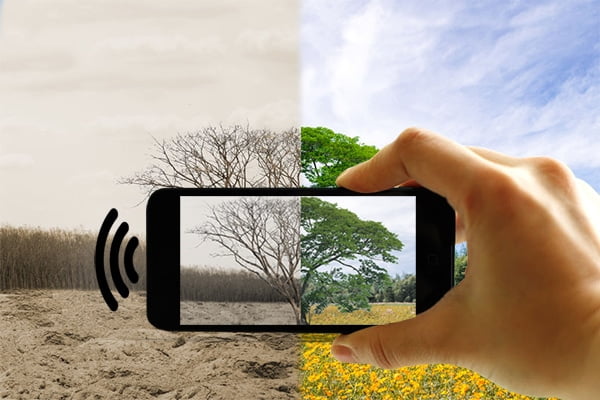Your cart is currently empty!

Environmental Impact of Wireless Devices: How EMF Radiation is Endangering the Planet
Last Updated on October 2, 2023

We might be the only species on Earth that uses electronic devices, but that does not mean we are the only species that suffers from their adverse health effects.
Electromagnetic Field radiation, or EMF radiation emits from our mobile devices, cell towers, power lines, and other wireless equipment. It has been shown to have biological effects on our cells, as well as interfere with many processes in our bodies. EMF radiation has been associated with everything from headaches and rashes to cancer and neurological illnesses.
Just like other unnatural environmental health hazards, humans bear a great responsibility. However, this byproduct of our new digitized world doesn’t just affect us.
This toxic pollutant is ever-present in our environment (thanks to us) as electrosmog, and it can affect every other living thing around us, both directly and indirectly.
And many plants and animals cannot adapt to these man-made emissions.
The Effects of EMF Emissions on the Environment
Emissions from natural and man-made sources make up the EMF radiation environment we live in. Natural sources such as radiation from the sun, the Earth’s magnetic field, and the atmosphere – including lightning discharges – account for a small fraction of radiation emissions.
On the other hand, artificial sources, namely major technologies, have quickly become the primary component of total EMF radiation emissions in the environment. And EMF research has shown there is abundant evidence of harm to diverse plant- and wildlife and laboratory animals, including: Ants, Birds, Forests, Frogs, Fruit flies, Honey bees, Insects, Mice, Plants, Rats, Trees.
An in-depth review from the EKLIPSE project found evidence that electromagnetic wireless signals pose a credible threat to wildlife. Radar, television and radio broadcasting, WiFi, 3G, 4G, and impending 5G communications, to name a few, create countless hazards to our environment and respective inhabitants. Scientists highlighted electromagnetic radiation as a potential risk to bird and insect orientation and movement, as well as to plant metabolic health.
The outcome of that study and others, that analyze EMF radiation and its connection to animal and/or plant life, signal major issues for our planet.
It’s important to remember how significant and precious animals, insects, and plants are to the productivity and well-being of our lives and environment. As small as they are, changes in their biome and population can wreak havoc up the entire food chain.
Bugs and Bees
A 2019 study concluded that nearly 40% of the world’s insect species are in decline.
We have previously written about the link between disappearing bees and increasing amounts of EMF exposure. These tiny yet vastly important insects are highly sensitive to electromagnetic fields, as are other insects. That’s because they rely on the Earth’s magnetic field to orient themselves and find their way back to their homes or hives. Granted, when thinking about a world with fewer bees and bugs, your first thought may not necessarily be compassionate because, well, bugs can be pests (pun intended)!
However, if this decline persists, the Earth may not have any insects at all by 2119!
Being less than 100 years away, this mass extinction will be witnessed – and very much felt – by our youngest generation. The repercussions of this loss could be catastrophic for Earth’s inhabitants. Insects, although anything but cuddly, are valuable. They are food sources for birds, fish, and mammals. Additionally, bees and other insects perform a significant role in fruit, vegetable, and nut production.
The loss of our bugs and bees could trigger a cataclysmic breakdown of the Earth’s ecosystems.
In fact, the loss of our insects has been labeled by many as the Sixth Mass Extinction in our planet’s history.
Human activities are largely to blame – activities such as deforestation, mining, and increased pollution from EMF transmissions like Bluetooth, WiFi, and cellular data, as well as from other toxins and gases being overproduced in our post-industrial world.
According to the International EMF Project, flight performance of insects can be impaired in electric fields above 1kV/m. In addition, bees experience significant effects when their hives, which are conductive, exist under power lines. The hives become electrically charged, thus causing injury or disrupting the activity of bees inside. This also applies to any un-insulated, un-earthed conductor-like environment, which can cause harm to plants, insects, birds, and other species.
Alfonso Balmori, author of “Anthropogenic radiofrequency electromagnetic fields as an emerging threat to wildlife orientation” states that the expansion of technology, especially wireless devices, caused increased electrosmog. He also says radio frequency fields in the MHz range can disrupt insect and bird orientation.
As stated earlier, these wireless signals interfere with bees’ and other insects’ ability to pick up on subtle electromagnetic fields given off by nature, thus rendering them unable to sense which direction to take home.
A documentary from 2021 called “Something is in the Air – The Cell Phone Radiation Documentary” demonstrates how honeybees are impacted by various levels of electromagnetic frequency. In the experiment, a microphone was installed inside a beehive to gauge how noisy the honey bees were at the various levels of cellular networks (2G-5G). The colony was disturbed after only 25-30 minutes at the 2G level because worker piping had been induced and the queen bee fled the hive with a large group of worker bees. At the 5G frequency level, the absorbed power rose from 3% to 370%, which eventually caused changes to their behavior, physiology, and morphology.
The decline of bees all over the world remains a problem, but is still not fully understood by scientists and beekeepers. Although bees are susceptible to diseases and attacks by wasps, ants, and other natural enemies, their plunge in population could be majorly due to the proliferation of towers and mobile phones.
Birds
Bees and insects are not the only life-forms that utilize magnetoreception, a sensory modality to detect a magnetic field to perceive direction or location; birds utilize this form of sensing as well. Therefore, their lives and abilities are also affected by EMFs.
In 2008, a laboratory study was conducted which focused on the effects of cell phone signals on fertile chicken eggs. The exposed groups of eggs were near a phone that was set up to call a ten-digit number every three minutes throughout the incubation period – the mortality rate was significantly higher for these groups compared to the unexposed.
Andrew Goldsworthy, the author of “The Birds, the Bees and Electromagnetic Pollution: How electromagnetic fields can disrupt both solar and magnetic bee navigation and reduce immunity to disease all in one go“, states that many of our birds are disappearing mysteriously from the urban environment, and there is increasing evidence that at least some of this is due to electromagnetic pollution such as that from cell towers, cell phones, DECT cordless phones, and WiFi.
EMF pollution interferes with birds’ navigation systems and their circadian rhythms, which in turn reduces their resistance to disease, thus killing off birds, one by one.
Scientists found that migratory birds, specifically migrating robins, became disoriented when exposed to electromagnetic fields at levels far lower than the safety threshold for humans. Migratory birds are unable to use their magnetic compass in the presence of urban electromagnetic noise. As the growth of wireless telecommunication technologies expands, the lives of birds are increasingly disrupted.
Plant Life
“Out of sight, out of mind” commonly applies to the issue of EMF radiation in relation to our environment.
What we can’t see, we often forget or fail to address in a timely manner. The power lines that hover over our farms and fields and electrical devices in close proximity have harmful, biological effects. There is undeniable significance between EMFs and plant life.
According to research published in the Review of Environmental Health peer-reviewed journal, some species of flora and fauna are uniquely sensitive to external man-made EMF emissions, in ways that “may surpass human reactivity.”
When NASA conducted research with plants, they noticed that some plants absorb EMF radiation. During their experiments, they were looking for plants that would sustain life in outer space and absorb one thing to produce more oxygen. Although these research efforts were not strictly focused on radiation, these experiments proved that plants have the ability to purify air and reduce EMF radiation.
While this is good news for humans since these plants may provide some protection from EMF radiation, the plants do not fare as well. Since they are absorbing the radiation instead of us, they will suffer in terms of growth and life-span. Plants cannot be expected to totally remove the radiation and toxins from your environment.
Malka N. Halgamuge conducted an analysis of mobile phone radiation on plants, and her findings demonstrated physiological and morphological effects. Additionally, the results of this analysis demonstrate that maize, Roselle, pea, fenugreek, duckweeds, tomato, onions, and mungbean plants are highly sensitive to EMF radiation. Similar to the effects on animals and insects, the findings of this analysis suggest that plants are more responsive to certain frequencies.
Studies have also concluded that wireless EMF frequencies cause physiological and morphological changes in plants as well as altered growth and adverse cell characteristics such as thinner cell walls and smaller mitochondria.
According to a review shared in the Biology and Medicine journal, Sivani and Sudarsanam collected 919 research papers on birds, bees, plants, other animals, and humans in relation to the harmful effects of EMFs. Of those 919 research papers, over half showed impact from EMF radiation.
In the same review, the authors suggested: “One can take the precautionary principle approach and reduce RF-EMF radiation effects of cell phone towers by relocating towers away from densely populated areas, increasing height of towers or changing the direction of the antenna.”
However, that’s easier said than done.
Nevertheless, research is expanding on this topic, and more news is coming to light regarding the negative impact of EMFs. Additional long-term experiments are needed to observe the effects of EMFs on plants and other life-forms, considering that plants have the power to impact human welfare and health, directly and indirectly.
The Time is Now
Unfortunately, laws and guidelines are not in place to adequately protect our wildlife, yet the truth remains – EMF radiation interferes with almost all life forms in some way.
The health effects of EMFs are the subject of ongoing research.
According to a 2021 research publication, “broad wildlife effects have been seen on orientation and migration, food finding, reproduction, mating, nest and den building, territorial maintenance and defense, and longevity and survivorship.”
The authors of the EKLIPSE review state that there is an urgent need to further research the scientific knowledge of EMF and respective impacts on the environment. This new evidence can position policy-makers to make decisions and frame their guidelines with the environment in mind.
And they’re absolutely right.
The time to act is now. The effects of EMFs on animals, insects, and plant life have a domino effect on the planet because these creatures are heavily responsible for the food we eat, the air we breathe, and the environment in which we live.
When their health is impacted, our health is impacted, too, and our world is consequently influenced in a detrimental way. Although wireless technology shows no signs of slowing down or decreasing, we must be mindful of how and when we use our devices to reduce the risk of damage, not only for ourselves but for the non-human species.
Related Posts
None found























































